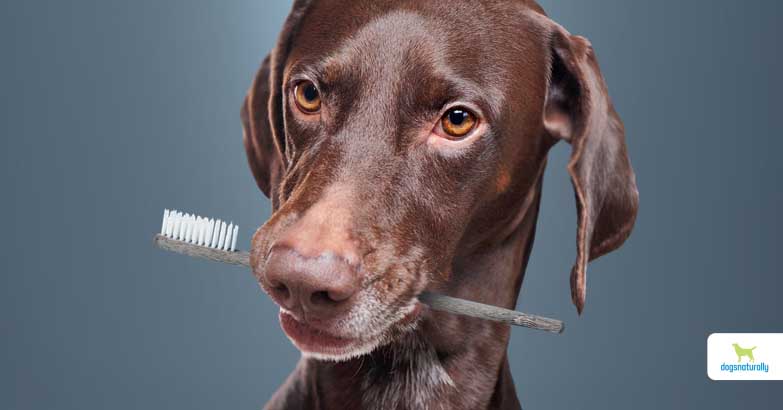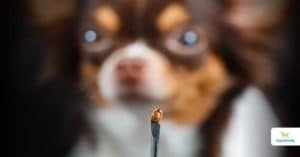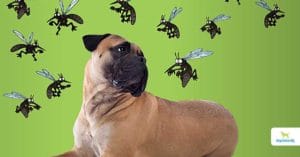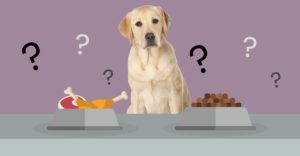Your dog’s dental health relies on a healthy microbiome in his mouth. Like his gut microbiome, he needs beneficial bacteria to overcome pathogenic bacteria that lead to diseases like gingivitis and periodontal disease. Dog teeth cleaning can minimize bad bacteria and prevent diseases from taking hold in his body.
There are 2 main types of dog teeth cleaning:
- Professional dog teeth cleaning by a veterinary dental specialist under anesthesia
- Anesthesia-free dog teeth cleaning
Here’s what you need to know about both methods.
2 Dog Teeth Cleaning Options
These are the main methods for cleaning your dog’s teeth to keep his teeth and gums healthy.
1. Dog Teeth Cleaning Without Anesthesia
Anesthesia-free dental cleaning is the regular method used on people all the time. And it can be done on dogs too. Most clinics provide this service by a veterinarian or a trained veterinary technician.
Anesthesia-free cleanings follow a four-step process:
i. An ultrasonic cleaner or dental hygiene scaling instrument cleans the teeth and the area under the gum line.
ii. Using a probe, the technician will check for problems below the gum line.
iii. The teeth are polished to remove tartar and staining.
iv. The mouth is rinsed with a natural antiseptic to clear debris from the procedure.
There are many reasons you might choose this type of teeth cleaning for your dog.
Benefits of Anesthesia-Free Dog Teeth Cleaning
Here are the benefits that appeal to many dog owners:
- Blood work or medication aren’t required
- No side-effects from anesthesia
- No recovery time
- Duration is short at only 45-60 minutes
- Cleaning is performed by dental technicians
- Can be done on older dogs with health issues that can’t withstand anesthesia
- It’s a shorter procedure that can be done on pets with anxiety
- An alternative for dogs with low blood pressure, low heart rate or low blood oxygen
- An alternative for dogs with poor kidney or liver function or heart issues
- Can be done on dogs with a history of seizures
- An option for healthy pets with a small amount of tartar
- About ⅓ the cost of dog teeth cleanings with anesthesia
- A good option between cleanings done onder anesthesia
Not all dogs are able to have anesthesia-free teeth cleaning. Dogs have to accept being wrapped to secure them. And there are natural calming herbal remedies or Bach flower essences that can help. A technician needs to have a gentle technique to work with skittish or nervous animals.
But if your dog is aggressive, too nervous or has severe periodontal disease, anesthesia-free cleaning may not be a good idea. If your dog has dental issues, you should be referred to a veterinary dental specialist for the care and services they can provide.
DNM RECOMMENDS: Teef is a prebiotic powder that mixes in with your dog’s daily drinking water to improve your dog’s oral health. Buy Teef Now>>
Concerns About Anesthesia-Free Teeth Cleaning
There is concern within the veterinary community that this type of cleaning isn’t effective. Here are some concerns:
- That technicians aren’t properly trained
- That oral exams aren’t performed properly
- That they can’t or don’t identify health issues
- That they’re meant to replace other dental services
- That they’re performed without the oversight of a veterinarian
- That there isn’t standardized training and certification
Many veterinarians don’t recommend anesthesia-free teeth cleaning. They say that without anesthesia, you can’t get far enough below the gum line, and without x-rays you can’t always identify any deeper problems. Ideally, choose a clinic that operates in close consultation with a veterinary clinic. Then if X-rays or other services are needed, the support is there when needed.
Here’s how professional teeth cleaning differs and why it can be an option for your dog.
2. Professional Teeth Cleaning For Dogs
Most dog owners are reluctant to have teeth cleaning done under anesthesia … but for some dogs whose teeth require deeper care, professional teeth cleaning may be necessary.
Brushing your dog’s teeth is part of good oral hygiene and dental health … but it can’t provide the deep cleaning below the gum line that’s sometimes needed. A professional dental cleaning, under general anesthesia, enables a veterinary dental specialist to do a deep, 360 degree clean of every tooth and clean below the gum line. That removes plaque and tartar and the bacteria that produce toxins, proteins and free radicals. They can damage gums and lead to gingivitis, which leads to deeper dental disease and ultimately disease throughout the body.
Teeth cleaning also enables your dog’s dentist to take X-rays and evaluate the health of the jawline and tooth roots. She can also safely fill or extract teeth as needed.
If your dog does need a professional teeth cleaning, you can maintain your dog’s teeth with anesthesia-free dental cleanings after that. At that time, the technician can advise you if a more intensive cleaning or dental care is needed beyond their scope.
The Importance of a Veterinary Dental Specialist
A veterinarian with a dental specialty, DAVDC (Diplomate of the American Veterinary Dental College), should perform your dog’s oral exams and teeth cleaning. Your medical doctor wouldn’t perform your dental work … and the roles of veterinarians and veterinary dental specialists are not interchangeable either. She has the training to look for specific issues and specializes in your dog’s dental health.
RELATED: Natural Dental Care and Dog Teeth Cleaning …
The Importance of Professional Dog Teeth Cleaning
Just like a physical checkup, dog teeth cleaning can be an option to help improve your dog’s overall health. Here’s how.
Detects Warning Signs
With regular visits, your veterinary dentist will be able to note any loose teeth, tartar buildup, or bad breath that could be warning signs of gingivitis or periodontal disease. That can result in bone loss within the jaw bone that can lead to loosened teeth and other problems. When poor oral health goes unchecked, toxins and bacteria can lead to infection and become a source of chronic inflammation.
Detection Of Disease Below Gumline
As much as 60% of dental disease is involved below the gum line. This includes periodontal disease, which is considered the #1 disease in dogs. It affects 80% of dogs by 3 years of age. Dog teeth cleaning can detect periodontal disease that is linked to heart and kidney disease, arthritis, cancer and early mortality … a result of chronic inflammation caused by bacteria. Professional teeth cleaning will remove plaque, minimize bacteria and provide regular monitoring of your dog’s dental health.
Provides An Accurate Oral Exam
It can be difficult to provide an accurate oral exam in a dog who’s awake. Even with the most docile pet, it can be difficult to see into the back of the mouth or investigate below the gum line.
Removes Plaque You Can’t See
It’s difficult to see calcified plaque (it’s white, the same color as teeth) which is why you need a dental specialist. Plaque hardens into tartar. And you can’t see plaque until it turns brown so it can be missed by your regular veterinarian. But more importantly, inflamed gums are the most common indicator of disease, not tartar. Tartar (or lack of tartar) is not an accurate indicator of dental health. Your dog can have low tartar … and yet have inflamed gums.
Monitors Breeds Prone To Dental Disease
Regular checkups are needed for breeds like greyhounds that are genetically prone to dental disease. Small breeds and brachycephalic breeds (dogs with a flat face and crowded teeth) are also prone to dental disease so regular cleanings or anesthetic-free cleanings can be a proactive measure.
If you choose to have your dog’s teeth professionally cleaned, you can opt for anesthesia-free cleaning as a maintenance program. Here are a few other things you can do at home.
Dog Teeth Cleaning Options At Home
Keeping your dog’s teeth on a daily basis will minimize the need for extensive teeth cleaning. Here are a few things you can do between checkups.
- Brush your dog’s teeth with probiotics. The probiotics will add beneficial bacteria to your dog’s mouth and fight bad bacteria from plaque that can lead to gum disease or periodontal disease.
- Make your own dental sprays and wipes. Use MCT oil or broth and probiotics. Dip a soft cloth in both and wipe it on your dog’s teeth. Then you’ll avoid commercially made sprays and wipes that may contain chemicals and toxic ingredients you’d rather not put in your dog’s mouth.
- Give your dog dental chew toys with lots of texture that can help scrape the plaque off your dog’s teeth so your dog can relax and do what he enjoys … chewing.
- The closer your dog’s diet is to the diet of his wild cousins … raw meat, organs and bones … the better it will be for his teeth. Chewing, gnawing and tearing meat and meaty bones will help loosen plaque on his teeth. It’s also thought that live enzymes in raw diets help maintain oral health. Despite what the manufacturers say, kibble does not clean your dog’s teeth.
- Daily brushing with a dog-friendly toothpaste and a soft brush, cloth or finger brush will reduce the buildup of plaque before it becomes tartar that can lead to more serious problems.
RELATED: Toothpaste Recipes for Dog Teeth Cleaning …
Even if you’ve been practicing some of these teeth cleaning methods with your dog at home, a regular checkup is the best way to ensure your dog has not developed any dental problems.
How Often Should Dogs Get Their Teeth Cleaned?
Adult dogs may need a professional teeth cleaning between 2 and 3 years of age or at the very least, an oral exam. This will give a good overview of their dental health. Smaller dogs and brachycephalic breeds prone to dental disease may need more frequent cleanings or anesthesia-free cleanings at least twice a year.
Some veterinarians may recommend annual teeth cleaning under anesthesia, but if you do some home care and feed a fresh, whole food raw diet, your dog’s teeth should stay healthier.
How Much Is Dog Teeth Cleaning?
As a general rule, professional dog teeth cleaning costs between $400 to $1,000. This depends on the region of the country, the size of dog and the degree of cleaning needed. Some clinics will include the cost of X-rays so you should confirm that in advance. There are additional costs if treatment is needed for periodontal disease or tooth extractions. These can add several hundred dollars to the total cost. But if you take your dog in for regular checkups, your cost should be at the low end if a cleaning is needed. Anesthesia-free cleanings can cost $100 to $300.
Being proactive about your dog’s dental health and ensuring your dog’s teeth have regular cleanings will go a long way toward avoiding dental disease and infections.
RELATED: How To Clean Your Dogs Teeth














